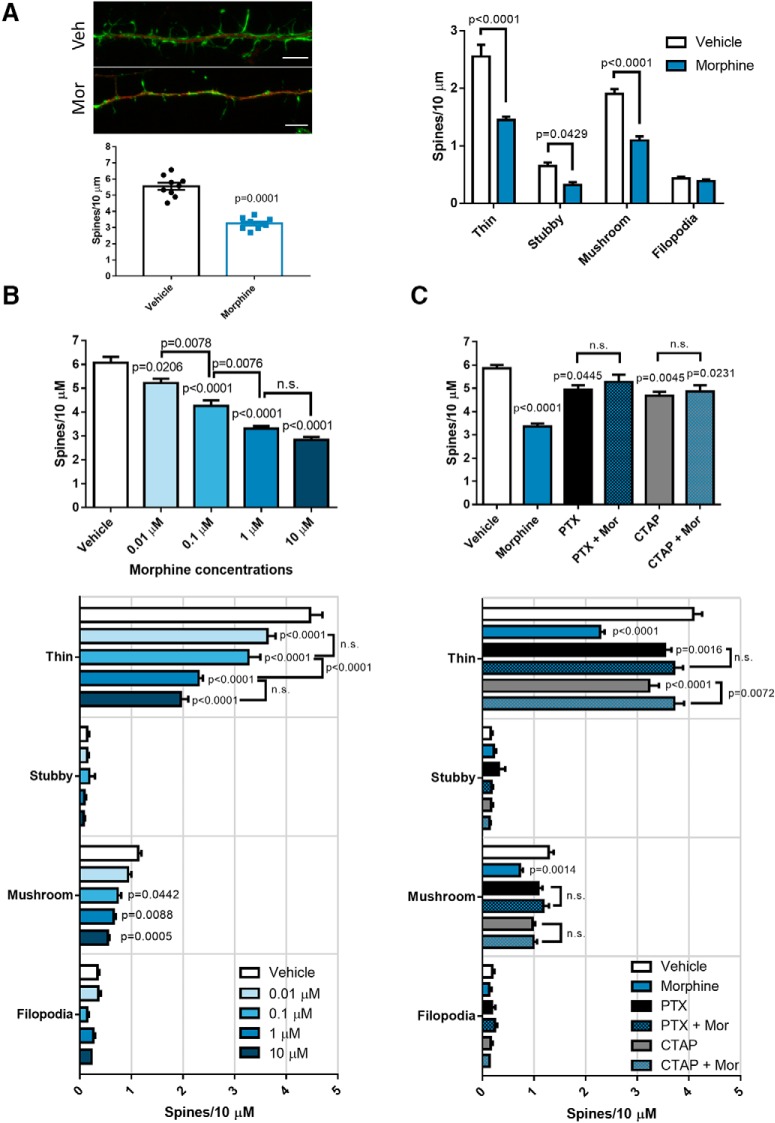Figure 3.
Morphine dose dependently reduces dendritic spine density and mature spine types through µOR and Gαi signaling. A, Morphine reduced several dendritic spine types in neurobasal cultures. Cultures (20 DIV) were treated with morphine (1 µM, 24 h), followed by fixation and staining with antibodies against MAP2 and with phalloidin 488 counterstain to visualize dendritic spines in MAP2-positive neurons; scale bar = 5 µm. Morphine significantly reduced overall dendritic spine density (t(16) = 9.372) and specifically reduced the density of thin, stubby, and mushroom spines. Dendritic spine density data were analyzed by two-tailed Student’s t test, while dendritic spine morphology data were analyzed by two-way ANOVA with Sidak’s multiple comparisons test (treatment F(3,64) = 151.9, p < 0.0001; morphology F(1,64) = 81.83, p < 0.0001). B, Morphine decreases dendritic spine density in a dose-dependent manner. Neurobasal cultures (20 DIV) were treated with morphine (0.01, 0.1, 1, or 10 µM) or vehicle for 24 h before fixation. As in A, treated cultures were stained with antibodies against MAP2, and counterstained with phalloidin 488 to visualize dendritic spines in MAP2-positive neurons. Morphine reduced overall dendritic spine density dose dependently, and each dose up to 1 µM reduced spine density significantly more than the previous dose; F(4,40) = 50.32, p < 0.0001. Spine morphology analysis showed the same dose-dependent reduction of thin and mushroom spines. All morphine doses significantly reduced thin spine density, while only 0.1, 1, and 10 µM morphine significantly reduced mushroom spine density; treatment F(4,160) = 42.9, p < 0.0001; spine morphology F(3,160) = 956.9, p < 0.0001. C, Morphine’s actions on dendritic spines depend on µOR and Gαi protein activation. Neurobasal cultures (20 DIV) were either treated with morphine (1 µM, 24 h) alone or pre-treated with the µOR antagonist CTAP (1 µM) or the Gαi protein inhibitor PTX (200 ng/ml) for 30 min/2 h before morphine treatment, respectively. Morphine alone significantly reduced dendritic spine density, which was blocked by cotreatment with both CTAP and PTX; F(5,42) = 15.29, p < 0.0001. Spine morphology analysis revealed a similar pattern where morphine significantly reduced thin and mushroom spine density, which was rescued by PTX and CTAP pre-treatment; treatment F(5,168) = 17.39, p < 0.0001; spine morphology F(3,168) = 1448, p < 0.0001. N = 3 experiments for all panels. Spine density data were analyzed by one-way ANOVA and Tukey post hoc, while spine morphology data were analyzed by two-way ANOVA and Tukey post hoc.

